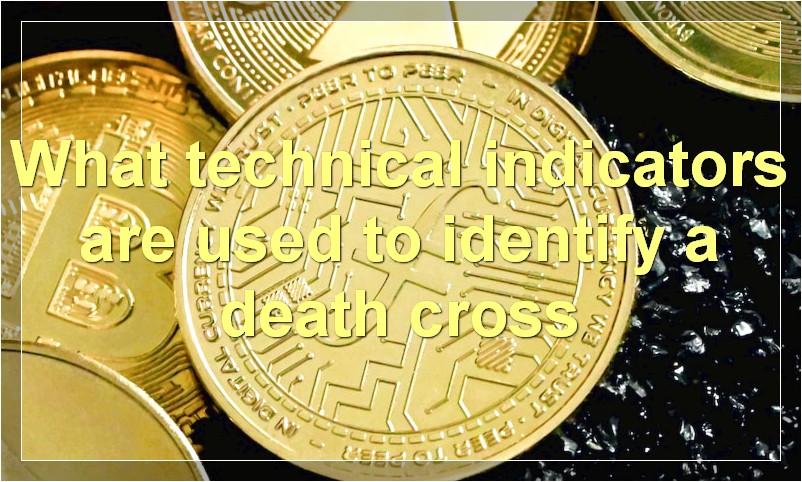Many people believe that the death cross is a sign of bad things to come, but there is more to this symbol than meets the eye.
What is a death cross

A death cross is a technical analysis indicator that is used to signal the potential for a bearish reversal in the price of an asset. The death cross occurs when the 50-day moving average crosses below the 200-day moving average. This is considered a bearish signal because it indicates that the short-term trend is losing momentum and the long-term trend may be about to reverse.
The death cross is a popular indicator among traders and investors because it can be used to time entries and exits in a variety of markets. For example, if you are looking at a chart of a stock that is in a long-term uptrend, you might wait for a death cross to occur before selling your position. This is because the death cross signals that the long-term trend may be about to reverse, which could lead to a decline in the stock price.
While the death cross can be a useful indicator, it is important to remember that it is not perfect. There will be times when the death cross occurs but the price does not reverse. This is why it is important to use other technical indicators and fundamental analysis in addition to the death cross when making trading decisions.
What causes a death cross
A death cross is a technical indicator that is used in charting to signal the potential for a bearish reversal in the price of an asset. It is created when the 50-day moving average crosses below the 200-day moving average. This crossover typically happens after a prolonged period of upward price momentum, and it can be seen as a sign that the market is losing faith in the current uptrend.
The death cross is thought to be a bearish indicator because it signals that the market has lost its upward momentum and is now turning downward. When the 50-day moving average crosses below the 200-day moving average, it indicates that the short-term trend has reversed and that prices are likely to continue falling.
There are a few different ways to interpret the death cross, but one of the most common is to use it as a signal to exit long positions or to initiate short positions. Some traders also use it as a trailing stop loss, meaning that they will exit their position once the 50-day moving average crosses below the 200-day moving average.
The death cross can be a useful tool for traders who are looking to take advantage of bearish reversals in the market. However, it is important to note that this indicator should not be used alone, but rather in conjunction with other technical indicators and market analysis.
How can a death cross be avoided
A death cross occurs when the 50-day moving average crosses below the 200-day moving average. This is considered a bearish signal and can be used to indicate that a downward trend is likely to continue. There are a few ways that investors can avoid a death cross:
-By using technical indicators: Technical indicators can be used to help identify when a death cross is likely to occur. For example, if the 50-day moving average is starting to move closer to the 200-day moving average, this could be indicative of a potential death cross. By monitoring these indicators, investors can take action to avoid the death cross.
-By diversifying their portfolio: Diversifying one’s portfolio can help to mitigate the risk associated with a death cross. For example, if an investor has a portfolio that is heavily weighted in stocks, they may want to consider adding some bonds or other asset classes. This will help to protect the portfolio should the stock market experience a sharp decline.
-By using stop-loss orders: Stop-loss orders are designed to limit an investor’s losses in a security. For example, if an investor has a stock that they purchased for $100 and sets a stop-loss order at $95, this means that they are willing to sell the stock if it falls to $95. This can help to prevent large losses in the event of a death cross.
What is the difference between a death cross and a bearish crossover
A death cross is a technical indicator that occurs when the 50-day moving average crosses below the 200-day moving average. This signals that the short-term trend is now bearish and that prices are likely to continue falling in the days and weeks ahead. A bearish crossover, on the other hand, is simply when the 50-day moving average falls below the 200-day moving average – it doesn’t necessarily signal that prices will continue falling.
What technical indicators are used to identify a death cross

One technical indicator that is used to identify a death cross is the moving average convergence divergence (MACD). This is a trend-following momentum indicator that shows the relationship between two moving averages of prices. A death cross occurs when the MACD line crosses below the signal line. This indicates that the short-term moving average has crossed below the long-term moving average, and it is a bearish signal.
What is the history of the death cross
The death cross is a term used in technical analysis that refers to the crossover of a security’s moving average. The death cross indicates that the security is in a downtrend.
The term was first coined by technical analyst Edmund Halley in the late 19th century. Halley noted that the death cross appeared before major market sell-offs.
The most famous death cross occurred in 1929, just before the stock market crash that ushered in the Great Depression. Other notable death crosses happened in 1974, 2000, and 2007-2008.
So, what does the death cross mean for investors? Many believe that it is a sign that a market decline is imminent. However, it is important to note that the death cross is not a perfect predictor of market crashes. In fact, false positives are fairly common.
Still, the death cross is something that all investors should be aware of. It is a powerful tool that can help you make more informed investment decisions.
Is the death cross a reliable indicator
The death cross is a technical indicator that is used by some traders to signal when a security is about to enter a bear market. The death cross occurs when the 50-day moving average crosses below the 200-day moving average. This is often seen as a bearish sign, as it indicates that the short-term trend is now bearish. However, some traders believe that the death cross can be a reliable indicator of a impending bear market.
What are some criticisms of the death cross
Some criticisms of the death cross are that it is a lagging indicator, and that it is not as reliable in predicting market reversals as other technical indicators.
How can the death cross be used in trading
The death cross is a technical indicator that is used by traders to signal the end of an uptrend. The death cross occurs when the 50-day moving average crosses below the 200-day moving average. This is considered a bearish signal and indicates that the market is likely to continue its downtrend.

